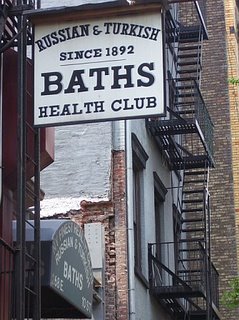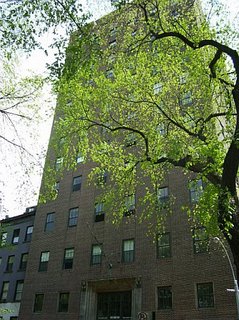 Start on East 7th Street near Avenue A, at St. Mary's American Carpatho-Russian Orthodox Church (#1., 121 East 7th Street). The building started out as part of the Hungarian Reformed Church, then the Carpatho-Rusyns moved in. The group is pretty evenly split between the Green Catholic and Orthodox Churches, and in the United States in the early 20th century it was not uncommon for entire parishes to go from one to the other. Like this one. The Carpatho-Rusyns here started out as Ressurection Greek Catholic Church, and then became the Eastern Orthodox Church of SS. Peter and Paul. They settled on the name St. Mary's in the 1960s.
Start on East 7th Street near Avenue A, at St. Mary's American Carpatho-Russian Orthodox Church (#1., 121 East 7th Street). The building started out as part of the Hungarian Reformed Church, then the Carpatho-Rusyns moved in. The group is pretty evenly split between the Green Catholic and Orthodox Churches, and in the United States in the early 20th century it was not uncommon for entire parishes to go from one to the other. Like this one. The Carpatho-Rusyns here started out as Ressurection Greek Catholic Church, and then became the Eastern Orthodox Church of SS. Peter and Paul. They settled on the name St. Mary's in the 1960s. 
Just a couple doors down is New York Citys first Polish Roman Catholic parish, St. Stanislaus Kostka (#2., 101 East 7th Street). The parish started out in 1872, but the building was not built until 1900-1901. Outside the building are a bust of Pope John Paul II, and a memorial plaque to the Poles who died in the September 11 attacks.
 Walk down to the corner of Avenue A and turn left. In the middle of the block, you'll see Odessa Cafe and Bar (#3., 117 Avenue A) and Odessa Restaurant (#4., 119 Avenue A). Both are great spots for a quick bite.
Walk down to the corner of Avenue A and turn left. In the middle of the block, you'll see Odessa Cafe and Bar (#3., 117 Avenue A) and Odessa Restaurant (#4., 119 Avenue A). Both are great spots for a quick bite.
 Continuing across East 7th Street to the southwest corner of Tompkins Square Park, take note of the Paderewski Tree (#5.), a tribute to Polish composer Ignacy Jan Paderewski, who died in New York in 1941. The tree was dedicated on the 60th anniversary of Paderewski's death by then-mayor Fiorello LaGuardia. It was sponsored by local Polish organizations and St. Stanislaus Church, where Paderewski was once a parishoner. The corner is also the home of the Tompkins Square Park Greenmarket.
Continuing across East 7th Street to the southwest corner of Tompkins Square Park, take note of the Paderewski Tree (#5.), a tribute to Polish composer Ignacy Jan Paderewski, who died in New York in 1941. The tree was dedicated on the 60th anniversary of Paderewski's death by then-mayor Fiorello LaGuardia. It was sponsored by local Polish organizations and St. Stanislaus Church, where Paderewski was once a parishoner. The corner is also the home of the Tompkins Square Park Greenmarket.
Back over on Avenue A across the street from the northwest corner of Tompkins Square Park is Manhattan's other Carpatho-Russian Orthodox parish, St. Nicholas (#6., 228 East 10th Street). Originaly a mission chapel of St. Mark's in the Bowery, the Carpatho-Rusyns acquired the building in the late 1920s. It was built in 1883 by James Renwick Jr. (architect of, among other things, the Smithsonian Institution in Washington D.C.) and W.H. Russell, and was featured in the 2001 film A Legacy of Faith.
 Just down the street is an East Village institution, the Russian & Turkish Baths (#7., 268 East 10th Street), founded in 1892. The place offers a full selection of banya treatments, as well as Russian soulfood at Anna's Restaurant.
Just down the street is an East Village institution, the Russian & Turkish Baths (#7., 268 East 10th Street), founded in 1892. The place offers a full selection of banya treatments, as well as Russian soulfood at Anna's Restaurant. Now cross back and enter Tompkins Square Park. Behind the pavillion near the athletic courts is the General Slocum Memorial (#8.). This isn't really a Slavic site per se, but bear with me. The marble monument commemorates the General Slocum Disaster of 1904, which claimed the lives of over 1000 Germans from the East Village (then known as Kleindeutschland, or Little Germany).
Now cross back and enter Tompkins Square Park. Behind the pavillion near the athletic courts is the General Slocum Memorial (#8.). This isn't really a Slavic site per se, but bear with me. The marble monument commemorates the General Slocum Disaster of 1904, which claimed the lives of over 1000 Germans from the East Village (then known as Kleindeutschland, or Little Germany).
At the time, the area was home to more than 80,000 Germans but they quickly fled the neighborhood in the wake of the tragedy and resettled on the Upper East Side in Yorkville. It was with the exodus of the Germans that the Slavs first came to settle in the East Village and Alphabet City. One major institution for the Slavic newcomers sits across the park: Christadora House (#9., 1 Tompkins Square). Christadora House was founded by philanthropists in 1867 as a settlement house providing social services to Russians, Poles, Ukrainians, Carpatho-Rusyns and other Slavic immigrants in the neighborhood. The settlement house moved into this 17-storey building once it was completed in 1928. At that time it was the tallest building in the world dedicated to social services.
One major institution for the Slavic newcomers sits across the park: Christadora House (#9., 1 Tompkins Square). Christadora House was founded by philanthropists in 1867 as a settlement house providing social services to Russians, Poles, Ukrainians, Carpatho-Rusyns and other Slavic immigrants in the neighborhood. The settlement house moved into this 17-storey building once it was completed in 1928. At that time it was the tallest building in the world dedicated to social services.
Later, it hosted George Gershwin's first public recital, and, even later, it was where Iggy Pop wrote the song Avenue B. Today, it is home to luxuy condos.
 Continuing along Avenue B, youll come upon St. Brigid's Church (#10., 119 Avenue B). Though a Roman Catholic church, it hosted the nacent Ukrainian Catholic St. George parish from 1890 to 1905. Today, St. George is a Byzantine landmark on East Seventh Street, but St. Brigid's is facing the wrecking ball.
Continuing along Avenue B, youll come upon St. Brigid's Church (#10., 119 Avenue B). Though a Roman Catholic church, it hosted the nacent Ukrainian Catholic St. George parish from 1890 to 1905. Today, St. George is a Byzantine landmark on East Seventh Street, but St. Brigid's is facing the wrecking ball.
From here, make your way towards Avenue C. It's a good idea to check out the East Village Park Conservancy's Community Gardens map and pass by some of the local gardens on the way. Aim for El Jardin de paraiso (#11.) and Orchard Alley (#12.), both between Avenues C and D on East 4th Street.
 They sit on the same block as perhaps the most intriguing Slavic site in the neighborhood, the out-of-the-way San Isidoro y San Leandro Orthodox Catholic Church of the Hispanic Rite (#13., 345 East 4th Street).
They sit on the same block as perhaps the most intriguing Slavic site in the neighborhood, the out-of-the-way San Isidoro y San Leandro Orthodox Catholic Church of the Hispanic Rite (#13., 345 East 4th Street).
Few specifics are available about the building’s history, but it was built in 1895 as the first home of the Roman Catholic St. Elizabeth of Hungary parish. When that parish moved uptown to Yorkville, the building became the Russian - Greek Orthodox Chapel of the Holy Trinity serving the Russian and Greek embassies. Later, it became the Russian Orthodox Church of St. Nicholas, which eventually moved to East 97th Sreet.
Today, the building is part of the Western Orthodox Benedictine Friars of the Hispanic Mozarabic Rite, though it still bears the royal seal of the Russian Czars on its façade.
Finally, Alphabet City is also home to The Monastery of St. Mary of Egypt / Mercy House (#15., 320 East 3rd Street), established in 1994 by the Russian Orthodox Church Outside of Russia. After a dispute, however, the monastery switched allegiances and is now part of the parish of the Russian Orthodox Church’s St. Nicholas Cathedral on the Upper East Side at East 97th Street near Fifth Avenue.









6 comments:
we love you, Slav! this tour guide is a real treasure, we'll be sure to take it along on our next walk!
Let's not forget the KGB Bar and Christina, the gold-hearted bartender at the old Blue and Gold... great site, keep it up..
KGB Bar and Blue & Gold aren't in Alphabet City!
The Church on 4th Street is actually run by a Western Orthodox monk who follows the rule of St Benedict. (Hence "Benedictine Friars"). It is an Orthodox Church which uses the Orthodox Hispanic rite of Spain (sometimes called the Mozarabic rite.)
The double headed eagle is a common imperial Symbol, that was also common in old Spain, and historically almost every Orthodox empire, and Orthodox country today (it is still used in decoration in Greece and Serbia as well).
Odessa is a pearl of Ukraine and the Black Sea and lots of tourists visit this wonderful city every year. To feel an atmosphere of Odessa, visit its cozy cafes and talk to local people. Ukraine Travel Guide created a directory of the best Odessa cafes to help tourists. You may also find there tips on accommodation, car rent, theatre guide and much more. Actually, you will find there everything you may need for Ukraine tourism.
This blog post provides fascinating insights into East Village history.
Post a Comment